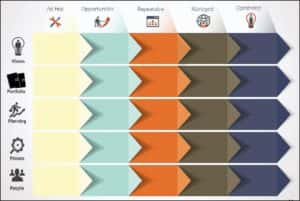
We learned in a recent webinar with Melinda Ballou, analyst at IDC and author of the IDC MarketScape: Worldwide Cloud PPM and PPM SaaS 2015-2016 Vendor Assessment that challenges facing today’s Program Management Offices (PMOs) are ever-changing; staying ahead of the curve has proven to be more challenging than ever as technology advances quicker than most organizations can adopt it. With this comes the need for a PMO or enterprise PMO (ePMO) to mature how they track and trace all work from request to delivery. keep the organization running efficiently and competitive by maturing processes. However, achieving higher PMO maturity requires a strong investment from both the PMO and the business, and not just in investment dollars, but in processes that supplement the investment to ensure the return on investment (ROI) of time, money, people, and tools.
Current Challenges
External factors of today’s changing technology landscape (social, cloud, big data, analytics) plays a large role in the impact of the PMOs the organization’s ability to keep driving the business. What remains to be seen is how this technology trajectory will continue and to what degree the PMO can adapt and leverage the change for sustained competitive advantage. While most organizations can adapt to changing demands, few can embrace the pressure of technology changes and stay ahead of the curve by fully absorbing the benefit of new technology. In order for a PMO to scale and be future-proof, it must continue along a maturity path that grows into repeatable processes and continuously adapts until processes are optimized. At this point, agility becomes systemic and business can execute in ways that competitors can not. The business leverages the PMO to be more competitive, and therefore the PMO is truly a value contributing entity — making it more strategic to the organization.
However, this is not always the case. There needs to be some degree of maturity in order for a PMO to establish itself as a central business unit and a key contributor to business success. For that, the PMO needs to identify where it currently stands and envision where they want to be before they can figure out how to get there. To go from what Ballou calls an “ad hoc” PMO of moving requests to “repeatable” and then “optimized,” the PMO needs to start by being in a stage she calls “opportunistic.” This requires executive support for the PMO and user adoption of process. Developing a governance process is the beginning of building a foundation for an effective PMO.
Knowing Where You Stand
In the webinar, Managing the Complexity of Today’s PMO, Melinda Ballou discussed the MaturityScape and MarketScape as it relates to PMOs in their current state and vision for the future. The MaturityScape shows the progression from a low maturity PMO through the phases to a high performing, mature PMO. The different phases of the MaturityScape are:
Ad Hoc: Doing the best you can – typically frequent failures, no scope on what can be executed)
Opportunistic: PMO is locally owned and not much authority or executive support. This stage is not very sustainable, but beginning to see more integrated plans and budgeting.
Repeatable: Start to have best practices and begin to see consistent behaviour. The PMO is building trust within the organization and has a center of excellence framework in place that is accepted by key stakeholders.
Managed: This level requires an auto configurable data driven environment where the PMO collects significant metrics to provide results back to the organization. This level supports higher growth and scaling up or down as needed to accommodate different types of projects. In a managed PMO, effectiveness is deeply rooted and teams begin mastering business innovation – bringing in mobile, social, and systems of collaboration together that drives business value.
Optimized: The final level that every PMO should strive to be. The PMO is continually adapting to business needs, responsive to dynamic competitive pressures, and able to utilize faster skills that need to move to different areas. An optimized PMO puts the business in a position to be successful where it can leverage the PMO for sustained competitive advantage and it becomes a core driver for business advancement.
IDC also outlines the MarketScape to establish vertical dimensions to establish PMO effectiveness in different areas. These include:
Vision – business objectives and governance
Portfolio – metrics and prioritization
Planning – scheduling, quality and change control
Processes – execution and project management
People – culture and collaboration
The Path Forward
Knowing where you stand is always the first part of getting to where you’re going, but you also need to identify where you would like to be, and what is realistic for your organization. Using the MaturityScape matrix as a guide, you can create a vision for where the PMO should be, and areas to improve in short and long terms. Setting goals and building trust by executing on commitments puts the PMO in a position to advance, gain the executive support needed, and build a culture of cohesiveness among users. Centralizing the data in a single system enables the PMO to not only provide visibility to garner the support, but also facilitates communication and accountability by having a centralized data source.
The end goal for any PMO should be to increase maturity, resulting in optimization, proactive agility, and a value contributing entity that propels the business forward. In order to get there, the PMO needs to evolve and take into account the unique factors that will inhibit growth, such as political agendas or cultural stereotypes, and create a plan to overcome them. By coupling process and organizational change with appropriate PPM automation and adoption to support the changes, the PMO can achieve much greater success and maturity.
While current challenges pose a threat to many PMOs from a productivity and achieving higher maturity standpoint, the landscape is always going to be difficult, and only makes the need for a PMO all the more. The reality of most PMOs is that the cost of not having processes and governance is much higher than the investment to implement them.





